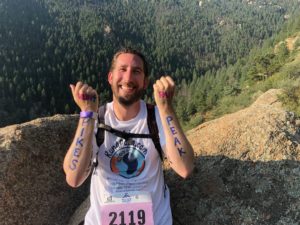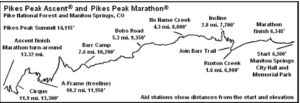
THE Toughest 13.1 Mile Race in the World
Click here to support new brain software to accelerate the collaboration of #ALZ worldwide!
How Challenging is Pikes Peak?
What does it take to run a race straight up 14,115 feet to the top of Pikes Peak mountain in Colorado? Although the average grade of slope is 11%, oxygen levels drop progressively as altitude rises, further compounding the uphill ordeal. The nature of the run (dirt trails, rock, and other natural obstacles) and the high altitude makes this race much more difficult than your standard 13.1 miles.
I thought I knew what was in front of me, but I had no clue. I heard tons of stories about how difficult this race was from fellow runners, and to be candid, I was very nervous I wouldn’t finish. One story seven years ago stuck in my mind from a running couple at the Great Wall of China Marathon, “We ran 50 half marathons in all 50 states, but failed to summit at Pike’s Peak. We missed the final cut-off and the trail was as tough as they come and the altitude was brutal.”
While I have completed every race to date, this one was giving me serious pause. I wasn’t 100% confident I would meet the cut-off times or cross the finish line. Despite running marathons all over the world, I was experiencing major internal anxiety.
The Ascent (or ascent portion of the Marathon) can take as long, or longer, than a full flatland marathon. In fact, many flatlanders find that it can take much longer! On the other hand, if you have trained in high altitude, it is possible to go a little faster than your flatland marathon time during the Ascent.
Since I don’t train, I assumed I would be running for 30 mins longer than my normal marathon time…

3 miles in as the altitude was kicking my behind
What should you know about the Pikes Peak Ascent?
1. Registration – If you want a shot at running this race, you must send the race director one of two official finishing times from a race that you completed within the last two years. You can submit either a full marathon time (6 hours or less) OR a half marathon time (2 hours and 30 minutes or less).
They are extremely strict about this rule and it’s non-negotiable .
2. Packet Pick Up – You must get your own packet and bring your own photo ID. For those of you who enjoy receiving swag giveaways from various companies, well, you will be in for quite a shock because you literally get your bib, a business card, and well, nothing else. While I normally toss out most of the swag I receive besides the running T-shirt, many people do enjoy all of these extras. The real swag is given when you cross the finish line. More on this shortly…
3. Wave Start and Cut-Off Times – a total of 1,800 people run the half and/or full marathon. You better stay in your corral, because if you cross the start line earlier than your scheduled gun time, you will be disqualified. I heard stories from people who had this happen in the past. In order to help alleviate course crowding, both the Ascent and the Marathon utilize a rolling wave start. Runners have been seeded into starting waves based on their qualifying times. The runners bib number defines the wave with bib numbers 1 through 199 in wave one, bibs 200 to 299 in wave two, bibs 300 to 399 in wave 3, etc. For example bib number 645 will start at 7:06, bib number 1347 will start at 7:13.
For the Ascent and Marathon, the on-course cut-off times are as follows:

In order to receive a finishers jacket and be listed as a finisher, Ascent runners must complete the entire course in under 6 hours 30 minutes; Marathon runners must complete the course in under 10 hours. These cutoffs are determined by your chip time (start time -> finish time).
Here is a link to answer any more FAQ’s
4. Race Day – you can feel the nervousness and excitement hanging around the start line. As I said above, I was anxious. More anxious than I can remember in recent time. Maybe it’s because I am getting older, or maybe it’s because I know what it takes on any given race day to sum up the mental and physical energy to run from A to B. I knew this mountain was going to be extremely difficult to conquer.

Elevation 9,500 feet. Hoping to reach Pikes Peak (not shown: insides in knots!)
The elevation gain (start to summit) is 7,815 feet. Take a minute to fully process that fact.
The start is at 6,300 feet and the summit is 14,115. The Ascent has very few stretches which are not going uphill. Thankfully, there are no exposed ledges, so there is little danger of falling off the trail!

The course and elevation breakdown.
This race was by far the toughest half marathon I ever ran (in the USA, if not the world). The altitude was harsh, the terrain was challenging, and the internal mental battle was constant throughout the entire race. Due to poor weather conditions, runners were turned around at Barr Camp, but I continued pushing forward with a few other runners. Sidenote: we should’ve just turned around like everyone else. We managed to reach the A-frame right near the tree lines, but we didn’t want to risk going any further. Like everyone else (eventually), we turned around and ended up running about 20 miles in total.
5. The bling and coveted finisher’s jacket – for a half marathon race, this bling is outstanding and every runner should want this medal in his or her collection! You can slide the runner on the medal back and forth and just knowing you made it to the top (unless you had our weather conditions) is worth every step.
In order to get your race pullover, you must make it to the top of the mountain. Although the threat of hail and lightning prevented us from summiting, finishers who completed the race under the cut-off time were able to receive this comfy pullover. To be fair, I wear it all the time when I travel.

Sweet justice, this puppy is comfy!

Back of the bling and jacket
In spite of the weather, I am left with an itch to return. Yes, it is always nice to accumulate new bling and sport a great pullover, nothing can actually replace crossing the actual intended finish line and summiting Pikes Peak.
I might have to book my flight again next year and go for round two.
Any takers?
